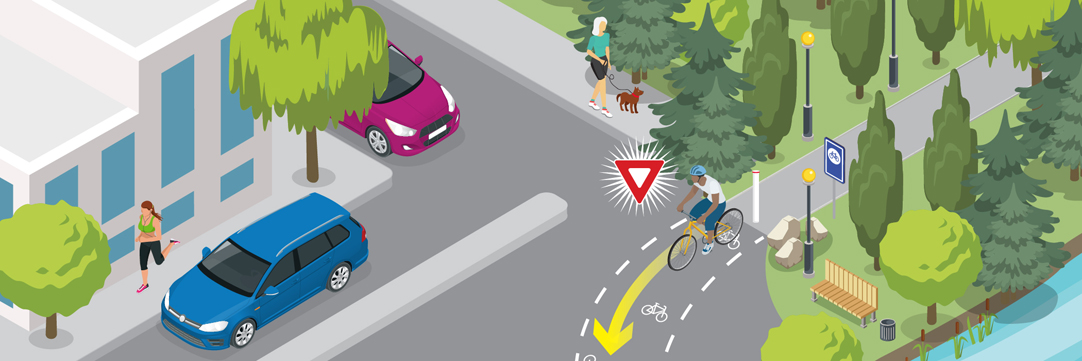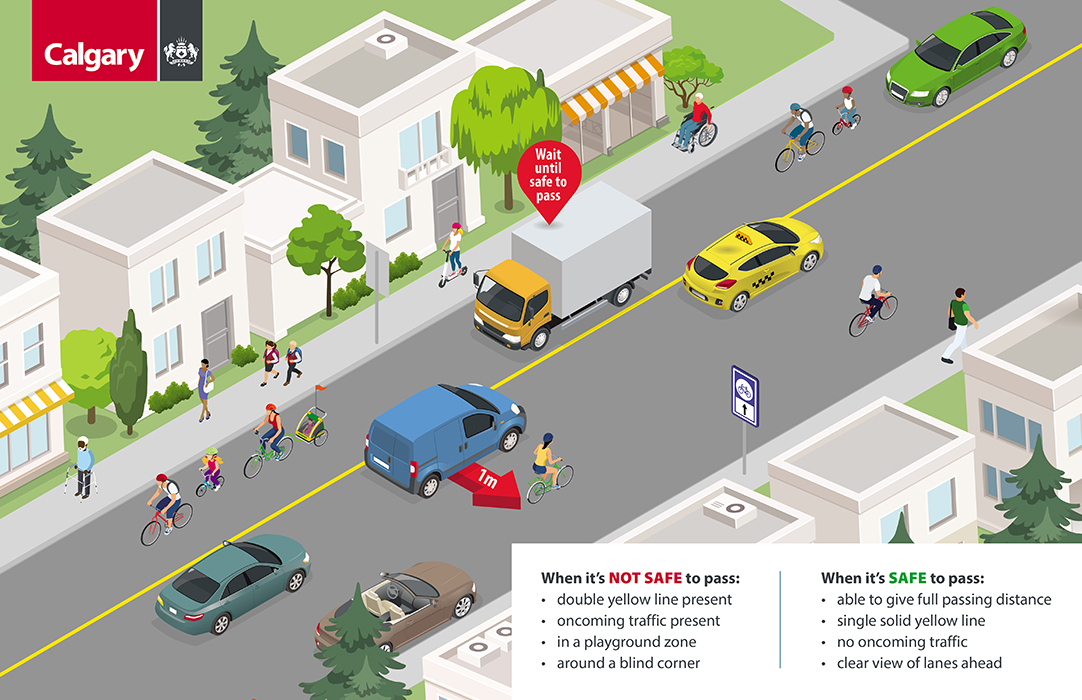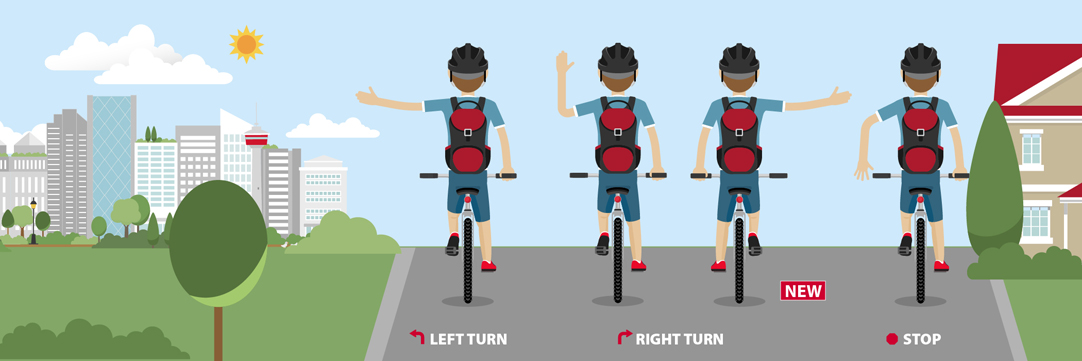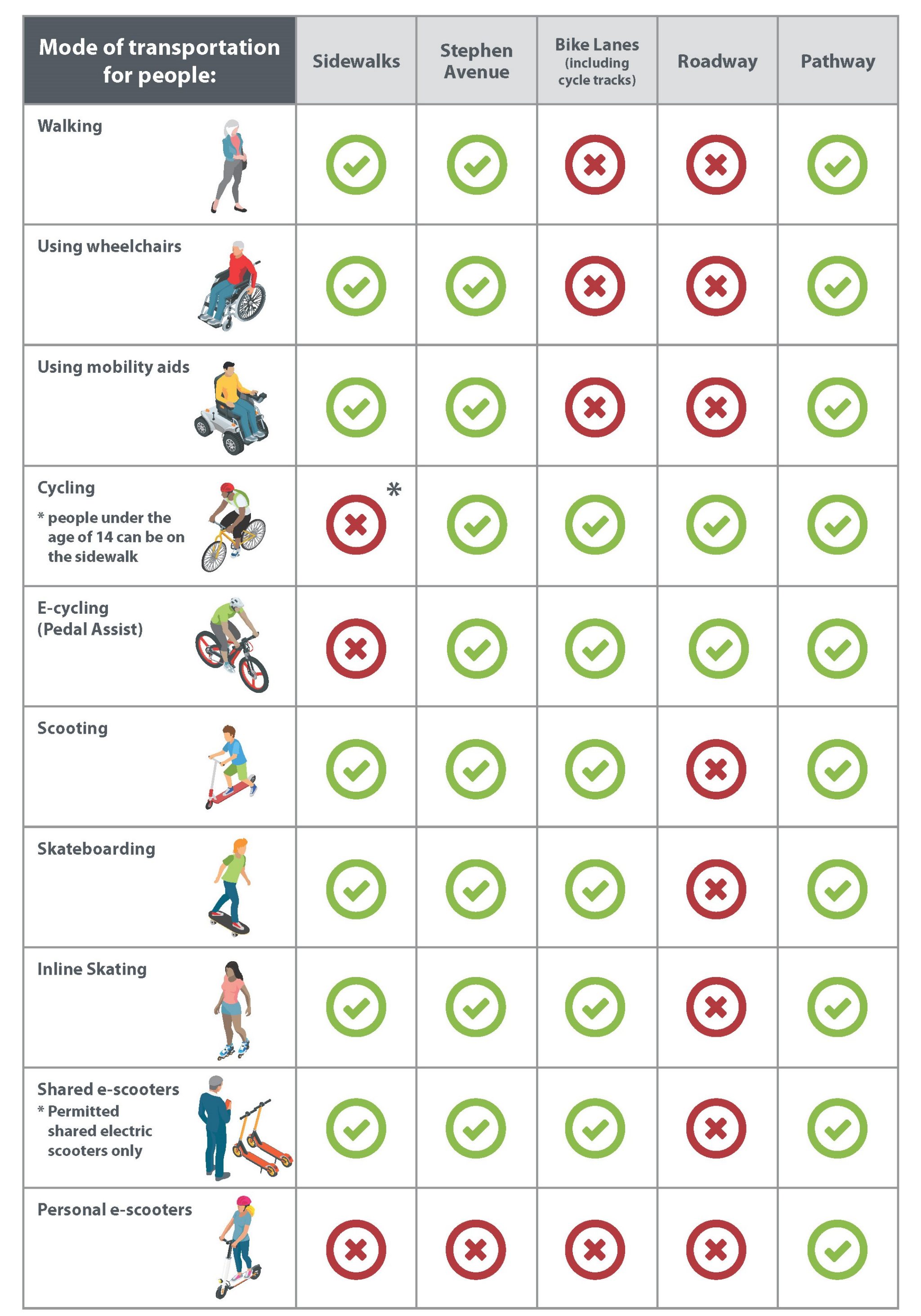Sharing the road safely
Whether you drive a car, pedal a bicycle, skateboard or scoot around Calgary, there are a few things you should know about safely sharing our roads and pathways with others.
Be safe. Leave space.
Sharing the road safely means leaving a minimum of 1 metre between your vehicle and the person cycling that you are passing. If it’s safe to do so, you may cross a single solid yellow line to create that space. Your vehicle is bigger, heavier and faster than a bicycle. People cycling trust you to help keep them safe by keeping your distance.
Leaving at least one metre of space is not just a courtesy: it’s a requirement. People driving 60km/h or slower are required by law to leave a minimum of 1 metre when passing someone cycling. When driving faster than 60km/hr, the distance increases to at least 1.5 metres of space to pass. Failure to leave the minimum safe passing distance may result in a $203 fine.
Be safe. Slow down.
Sharing the road safely means slowing down when passing a cyclist. If you can't pass safely with the minimum amount of space, slow down and wait for an appropriate opportunity to pass. When cycling, you are expected to ride as close to the curb as is safe to do so.
Be safe. Be heard.
Sharing pathways safely with others means letting them know you're nearby. When you can’t be seen by others, like when you are approaching from behind, make yourself heard. Make sure you have a bell on your bicycle – and use it when approaching others. You can also speak up – whether you are about to turn, stop or pass, announce your next move to those around you. When others on the pathway know your intentions, and you know theirs, everyone can cycle safer.
Be safe. Be seen.
Sharing pathways and roads safely with others means making your presence known. Make sure you have a white light on the front of your bicycle and adequate reflectors at the back and on the wheels. The added light and reflections helps show others where you are. Whether you are driving or cycling, when people can see each other coming, collisions are less likely to occur.
Safe passing for people driving
Know when it's safe - and not safe - to pass.
Safety tips for people cycling
Use these hand signals to indicate a right turn when cycling
A person cycling may use either the left or right arm to indicate a right turn.
Cyclists yield to traffic when entering a roadway
People cycling on a pathway approaching a roadway can yield instead of coming to a full stop.

More ways to get around Calgary
Did you know that Calgarians are legally allowed the use of motorized and non-motorized mobility devices (such as non-motorized and motorized scooters*, inline skates and skateboards) on the cycle tracks and in public spaces in the downtown core, including Olympic Plaza, Stephen Avenue Mall and Barclay Mall. See the More ways to get around Calgary poster for more details.
Mobility scooters for those with mobility challenges and wheelchairs are still not permitted on the cycle track, as per the Traffic Safety Act. People using mobility aids are considered pedestrians, so they are required to use the sidewalk.
*This applies to permitted shared electric scooters only. Privately-owned electric scooters may only operate on pathways.
Electric pedal assist bicycles are allowed on Calgary Transit during the same non-peak hours that other bicycles are permitted. Electric pedal assist bicycles weighing less than 55lbs are also allowed on bicycle racks on the front of City buses.
Frequently Asked Questions
Safe passing for drivers
When did the safe passing law take effect?
City Council approved the safe passing bylaw in March 2019 and the bylaw came into effect on September 1, 2019.
What do I need to do if I intend to pass someone cycling?
When driving at 60km/h, or slower you must leave at least 1m of space when passing. When driving faster than 60km/h, you must leave at least 1.5m of space when passing. If safe to do so, you can cross a single solid yellow line in order to pass a person cycling.
What is the fine for not leaving enough space when passing?
Failure to leave the minimum safe passing distance may result in a $203 fine as per the bylaw. People who cycle are expected to follow the rules of the road by riding as close to the curb as is safe to do so. People driving are permitted to cross a single solid yellow line in order to pass a person cycling, if it is safe to do so. If it is not safe to pass while leaving the minimum amount of space, slow down and wait for an appropriate opportunity to pass.
What do I do if there is currently no safe opportunity to pass someone cycling?
If there is not currently a safe opportunity to pass a person cycling (e.g. if there is traffic in the adjacent or oncoming lane, if you are in a playground zone, or if a double solid yellow line or median prevents giving enough space), then you must slow down your vehicle and wait for an appropriate passing opportunity.
Safe stopping for people who cycle
When I’m cycling on the road, am I required to stop at stop signs?
As per the bylaw, this only applies when there is the absence of any type of signage, like when a pathway transitions to an on-street bike lane. This does not give people who cycle permission to ignore posted stop signs on the roadway. All people who cycle must obey the rules of the road, including coming to a complete stop at a posted stop sign and adhering to all other posted signage.
Why aren’t Idaho stops permitted?
An Idaho stop is a common term for a law that allows people cycling to treat stop signs as yield signs. Sometimes it also includes treating a red light as a stop sign. Idaho Stops are currently illegal under the Traffic Safety Act Rules of the Road Regulations from the Province of Alberta. Bicycles are considered vehicles in the Alberta Traffic Safety Act. As such, regulations around stop signs apply to people who cycle in the same way it does to people who drive any other type of vehicle on the road.
Ways to get around Calgary
Why does The City allow skateboards, scooters and inline skaters on the downtown cycle tracks?
Allowing non-motorized personal mobility devices (skateboards, scooters, inline skaters, etc.) on bicycle infrastructure and in public spaces in the downtown core is a change introduced in 2019. It legalized behaviours that are commonly accepted and currently in practice. The bylaw change in 2019 reduces the risk of citizens being ticketed for socially acceptable travel behavior and encourages more active travel options. This also allows users to transition more easily from a pathway to a roadway or cycle track.
Why are mobility aids not allowed on the downtown cycle track?
As defined by the Traffic Safety Act, a mobility aid user is considered a pedestrian by provincial legislation and as such is not permitted to use the street for travel when there is a sidewalk available for pedestrian use. As all our cycle tracks are on roads that also have sidewalks, creating a bylaw to enable mobility aids to use the downtown cycle tracks would be in contradiction to the Traffic Safety Act and is, therefore, illegal.
Cycling bylaws
Did you know that several changes were made to Calgary transportation bylaws in 2019 to provide more choice and improve safety and predictability for Calgarians, no matter how they choose to get around our City? Find out more here:
- Summary of bylaw changes
illustration | video - Bylaw 1H2019 approved changes
- Bylaw 8M2019 approved changes
- Bylaw 9M2019 approved changes
- Report to Transportation and Transit Committee (Feb. 2019)
- Summary of public engagement




